Franz Schubert's Unfinished Symphony
Franz Schubert's Unfinished Symphony
In the autumn of 1822, Schubert embarked suddenly on a work which more decisively than almost any other in those years showed his maturing personal vision, the "Unfinished Symphony" in B minor
Six years intervened between the composition of the Fifth Symphony and that of the Eighth and during these years Schubert's spirit made such incredible progress toward maturity that with this Eighth Symphony he may be said to have reached the pinnacle of his musical genius. The two Symphonies that preceded this one (the Sixth, in C, and the Seventh, in E), though of positive historic interest, do not warrant detailed demonstration for our group; they were chiefly important as stepping-stones. It was the Unfinished that Schubert's symphonic genius seemed to burst all at once into flame.
Schubert - Symphony Unfinished
Beethoven was more profound, more scholarly, undeniably a spirit of far larger caliber and wider outlook; but in none of his works has Beethoven surpassed the tremendous primitive vitality, the mighty dramatic surge, the inescapable appeal of the Unfinished Symphony of Schubert. And surely no other than Schubert has ever produced so unique a masterwork at the age of twenty-five!
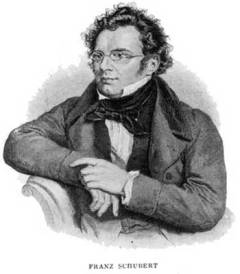
Franz Schubert
This Eighth Symphony (in B minor) consists of two Movements only, whence the title: Unfinished. Since Schubert's death at the age of 31, the symphony has been a bit of a mystery, but research has shed new light on the composer's original intentions.
Schubert himself fully sketched the third movement for piano, and wrote twenty measures for full orchestra, giving a clear template of his plan for orchestration. Using these materials, Schubert scholar Brian Newbould completed a beautiful realization of the scherzo. The fourth movement was drawn from Schubert's incidental music to Rosamunde. The composer had received a commission for the Rosamunde music while composing the Unfinished Symphony.
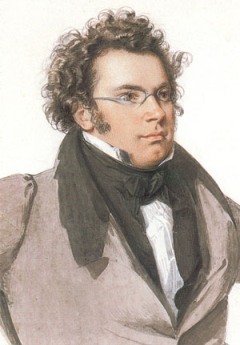
Franz Schubert
In dire financial need, Schubert re-directed the material of the fourth movement into the large orchestral 'entracte' of the play. Composer Mario Venzago reclaimed the music from Rosamunde and fashioned a dramatic finale to the symphony, creating a powerful and fully realized symphony.
1. Allegro moderato. A brief phrase emerges from black depths, superceded by chattering strings over which a solo clarinet floats the first subject. Silver-lined, with attendant clouds, it builds through surging crescendi to a rhyhmic climax, yielding to the glowing second subject on 'cellos. Passing to violins for elaboration, this halts in mid-flight: shattering chords send shivers through the strings. The tune resumes, acquiring a potent, trombone-led undertow brewing a bruising climax. Further lyrical extensions are severed by another jolt: a loud, unnerving chord, fading to troubled stalking. A full repeat leads into a development dominated by that sombre introductory phrase. Anger, if anything, fills the air: through a powerfully intense climax, a tense, nervous phase, to a huge crescendo of rushing strings, growling trombones, thumping tympani, and surging trumpets. Tumult subsides to admit the chattering strings and a recapitulation with a sting in its tail: have we been spared that sudden halt and shattering chords? No! Just when you think you're safe, bang! The coda, also driven by that all-pervading introduction, lifts, swells, sighs, climaxing briefly into brooding gloom.
Introduction
1st Subject (Theme)
2nd Subject (Theme)
2. Andante con moto is a deceptively simple-sounding structure: exposition and recapitulation of two subjects plus a coda based on the first subject. This is a strange animal: not variations (as you might expect), yet neither is it sonata. The nearest might be “truncated rondo, A-B-A-B-A”. The subjects, mildly different “song themes”, lack contrast. However, each has a central “variation” which is contrasted: the first subject acquires a stout, marching character (or as near to that as 6/8 can get!), while the second erupts into fierce passion reminiscent of the funeral march of Beethoven's “Eroica” Symphony. Nor is Schubert quite finished: the “exposition repeat” isn't, not quite! Almost everthing is subtly nudged. It's like deja-vu, but somehow the scenery isn't quite the same, the light and shade shifted, and it all points to the coda, introduced by the same questing violin phrase that links the two “expositions”. From a soft woodwind “chant”, the music at first gently opens out, then fades and fragments, settling onto a curiously regretful closing chord.
1st Subject (Theme)
2nd Subject (Theme)
In 1823, the Graz Music Society gave Schubert an honorary diploma. He felt obliged to dedicate a symphony to them in return, and provided to his friend Anselm Hüttenbrenner, who was a representative of the society, a score he had written in 1822. This much is known.
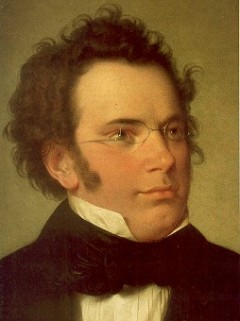
Franz Schubert
What is not known, and will almost certainly never be known, is how much of the symphony Schubert wrote, and how much of what he did write he gave to Hüttenbrenner. The following exists: the first two movements exist in full score, the first two pages of a scherzo in full score, and the remainder of the scherzo in piano score, but nothing of any fourth movement. A finale (fourth movement) in the home key (B minor) would have been the norm for any symphony written at that time, but there is no direct evidence that Schubert ever started work on this movement. It has been surmised that the Entr'acte from Rosamunde (written in B minor and with the same instrumentation as the symphony) was that fourth movement, which Schubert appropriated for the play, but scholars are not in agreement about this. There appear to have been pages torn out after the beginning of the scherzo.
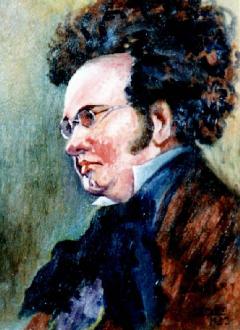
Franz Schubert
The fact that Hüttenbrenner did not have the piece performed, or even make the society aware he had the manuscript, is curious and has led to various theories. Was he given an incomplete score by Schubert and was waiting for the remainder to be provided before saying anything? If so, he waited in vain for the remaining five years of Schubert's life. After Schubert died in 1828, why did Hüttenbrenner not then make the existence of the manuscript known? Do the torn pages suggest he had somehow damaged the piece and managed to lose or even destroy the last two movements? Was guilt the reason he said nothing about the work's existence for 37 years after Schubert died? Old age and approaching death seem to have been a factor in Hüttenbrenner finally revealing the work. This happened in 1865, when he was 76 (he was to die three years later). He showed it to the conductor Johann von Herbeck, who conducted the extant two movements on 17 December 1865 in Vienna, adding the last movement of Schubert's 3rd Symphony as the finale. The score was not published until after 1867.
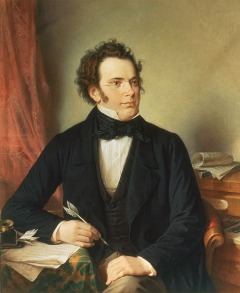
Franz Schubert
“Schubert?” I often hear folk say, “Oh, his music is nice.” Then there's that “lovely melody in the Unfinished”. But, the Unfinished isn't “nice” music, is it? The opening, emerging from pitch-blackness into mere night, belies “niceness”. At every turn, “nice” tunes charm us, only to be beset by turbulence. Doesn't this unprecedentedly explosive combination (no, I”m not forgetting Beethoven!) point towards Mahler? Now, I wonder: did Schubert drop it because he bared too much of his own anguished soul, and found the confrontation too painful?

Franz Schubert
Last Updated (Saturday, 14 March 2015 15:53)








